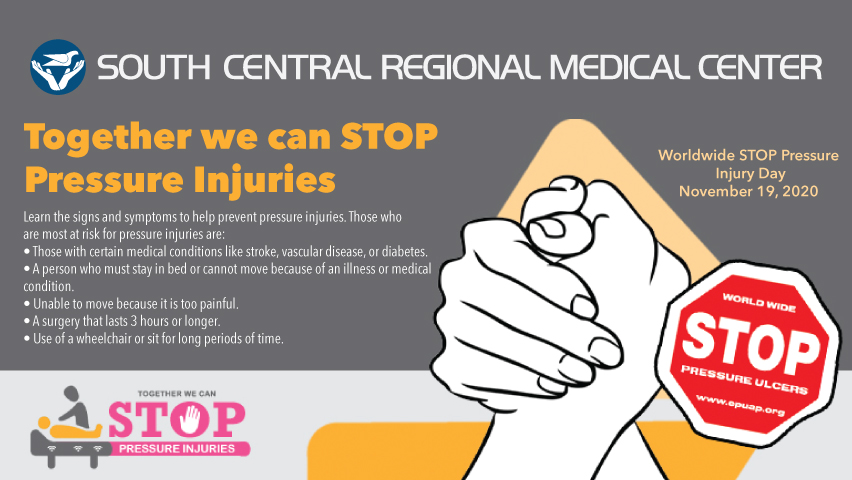World Wide Pressure Injury Prevention Day | November 19
Posted on November 16, 2020
Have you ever noticed that sitting in the same position can get uncomfortable over time? That feeling is your cue to change positions. However, if you are unable to move or adjust, constant pressure is put on your skin, which restricts blood flow. Without adequate blood flow, the skin and tissue beneath the skin can die and form wounds called pressure injuries.
Pressure injuries, formerly known as bedsores, are localized damage to the skin and underlying soft tissue. They usually form over bony prominences, such as the tailbone and heels, or from medical devices, such as a breathing tube that presses on the face.
Those who are most at risk for pressure injuries are:
- Those with certain medical conditions like stroke, vascular disease, or diabetes.
- A person who must stay in bed or cannot move because of an illness or medical condition.
- Unable to move because it is too painful.
- A surgery that lasts 3 hours or longer.
- Use of a wheelchair or sit for long periods of time.
If you or your loved one is at risk for a pressure injury or develops a pressure injury, talk with your healthcare provider to make a plan. Care plans can address a variety of factors that cause wounds or injuries, and help in the prevention or further occurrences of pressure injuries.
Types of plans include:
- MOVEMENT & COMFORT – Healthcare providers and caregivers may help you change positions at regular intervals. You may need to use a special bed or cushion that helps protect your skin. Your healthcare provider also will consider any appropriate medications.
- SKIN CARE & CLEANSING – Beyond properly washing and drying your skin, it is important to manage your sweat, bladder habits, and bowel habits. Gently wash, not scrub, your skin with a soft sponge or cloth. Your healthcare provider may recommend special cleansers and barrier products.
- DIET & NUTRITION – Proper nutrition helps keep skin and muscles strong, which helps prevent pressure injuries and promotes healing if a pressure injury occurs.
- Calorie Intake – Without enough calories, you may lose muscle mass and weight.
- Protein – Increased protein intake can help pressure injuries heal. Protein repairs and maintains tissue and muscle.
- Amino Acids – These are the building blocks of protein. The amino acids arginine and glutamine are critical in wound healing.
- Fluids – Staying hydrated ensures nutrients are spread throughout your body.
- Vitamins & Minerals – Many vitamins and minerals are associated with healing.
South Central Regional Medical Center Hospital joins other healthcare facilities throughout the world to observe World Wide Pressure Injury Prevention Day on Thursday, November 19th. Alecia Bigler, RN, Director of Continuum of Care states, “South Central Regional Medical Center is proud of the efforts put forth by our dedicated staff every day to prevent pressure injuries from occurring. Our mission is to provide excellent care and service to each patient and this is a constant goal for our patients who may experience a risk for a pressure injury.”
For more information regarding how to treat or avoid pressure injuries, please contact your local healthcare provider. For a listing of local providers within the South Central health system, CLICK HERE.
